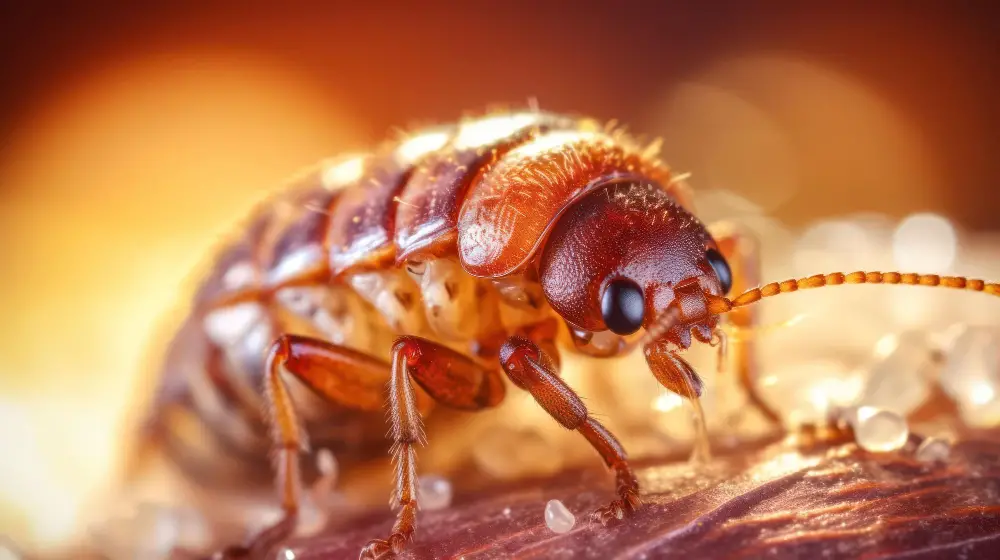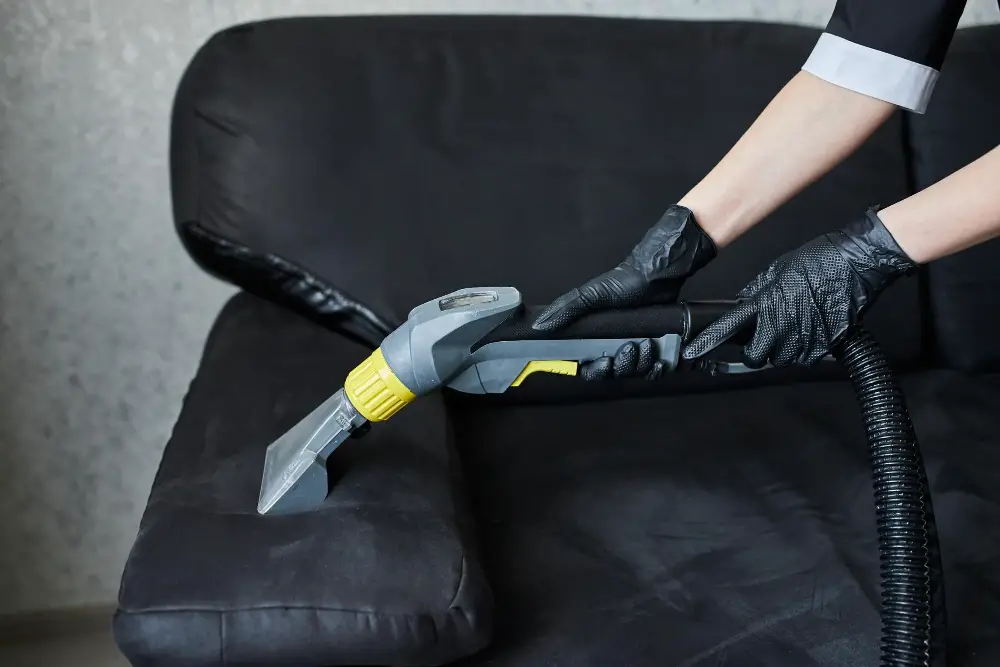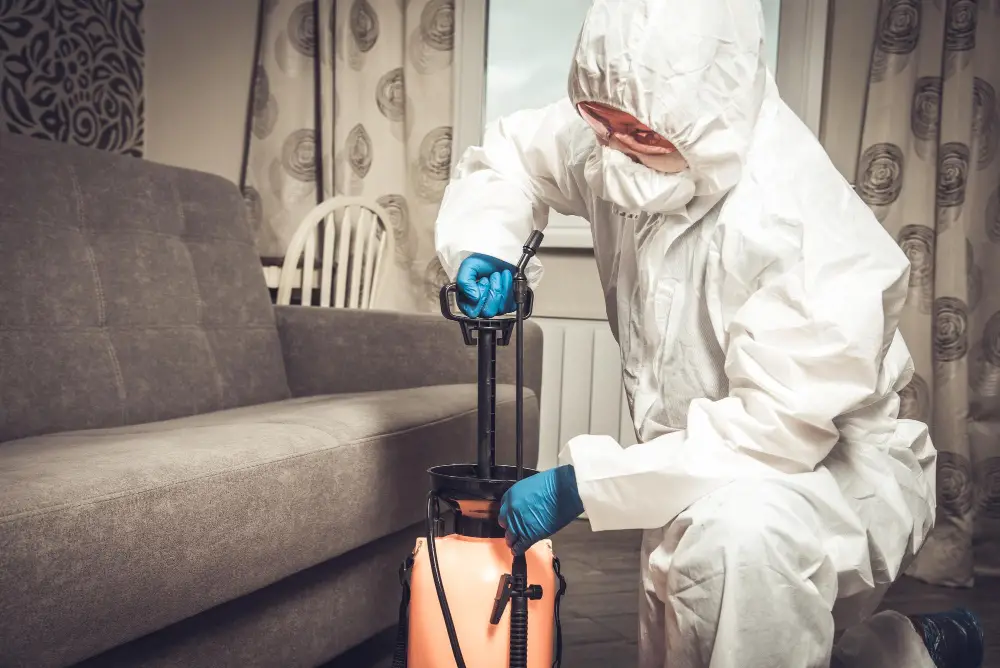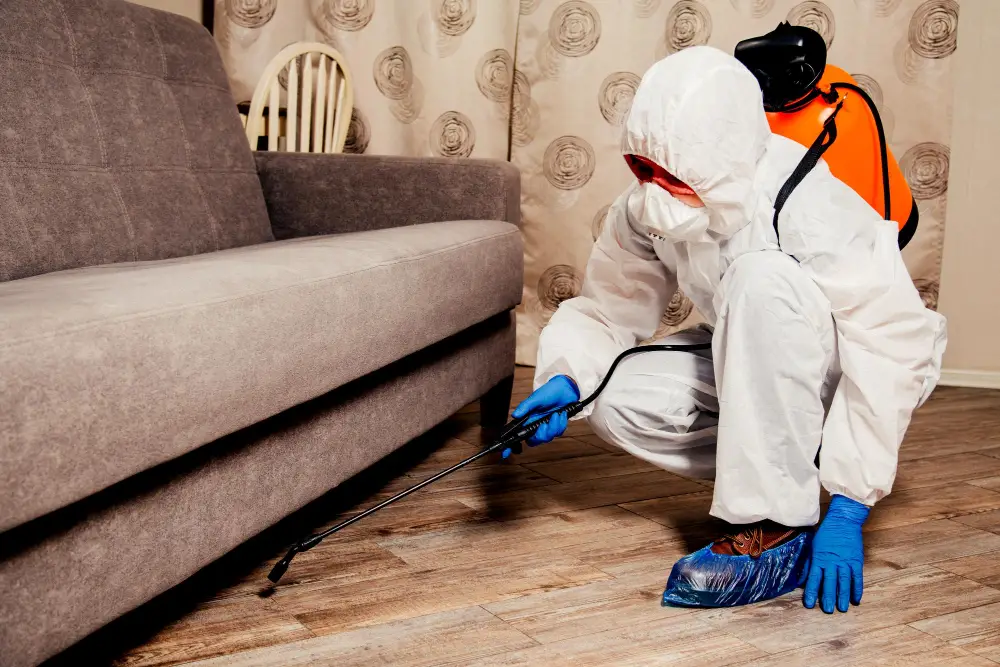Last updated on
It’s more important than ever to recognize signs of bed bugs on your couch, because understanding the extent of an infestation is the first step to eradicating those pesky critters.
Discovering bed bug eggs on your couch can be quite distressing. But fear not, there are effective ways to tackle this problem.
The first step is to confirm the presence of bed bug eggs. They are tiny, about 1mm in size, and are pearl white.
Once confirmed, you’ll need to take immediate action to prevent an infestation. This involves a thorough cleaning, applying appropriate treatments, and possibly seeking professional help.
This article will guide you through the process, offering detailed instructions on how to identify, remove, and prevent future bed bug egg infestations on your couch.
So, let’s get started and reclaim your couch from these unwelcome invaders.
Key takeaways:
- Confirm presence of bed bug eggs (1mm, pearl white)
- Take immediate action: clean, treat, seek professional help
- Treat different couch types with washing, vacuuming, steaming
- Use chemical treatments with safety measures, efficacy, proper usage
- Install interceptors to trap bed bugs, consider professional pest control
Table of Contents
Identifying Bed Bug Eggs On a Couch

Recognizing bed bug eggs isn’t simply about spotting tiny, pearl-white specks on your couch. It’s crucial to stay updated on the size and shape which typically measure about 1 millimeter, similar to a grain of salt. They are often found clumped together and are physically sticky, allowing them to adhere to surfaces.
Appearing translucent or a milky white, these eggs usually locate themselves in dark, hidden spaces, like seams, cracks, or crevices on the couch. Spotting small brown stains, shells, or molted skin along with a peculiar musty scent could also imply their presence. For a more accurate identification, consider using a magnifying glass and flashlight. Remember, detection is always the first critical step in the battle against these unwanted household pests.
Steps to Confirm Bed Bug Infestation On a Couch

Firstly, noticing small brown stains or shed skins on your couch might be a sign of bed bugs, as these creatures often leave traces of their existence in such a way. This is usually the result of bed bugs being crushed or their skins being discarded as they grow.
Secondly, pay attention to the smell. If you start noticing that your couch emits a musty, sweet odor similar to that of rotting raspberries, it might indicate a bed bug infestation.
Thirdly, carefully inspect the couch seams and crevices. These tiny insects and their eggs often hide in hard-to-reach places. Make sure to scrutinize all the seams, under the cushions, and even the furniture joints. To make your job easier, use a magnifying glass and a flashlight.
Finally, the infallible sign of an infestation is seeing the bugs or their eggs yourself. Adult bed bugs are about the size of an apple seed and have a reddish-brown color, while the eggs are tiny, about 1mm in size, and are white or a light cream color.
Remember, proper identification is key. While other insects such as carpet beetles or booklice might resemble bed bugs, their behaviors differ significantly, and hence, so do their treatments. If unsure, contact a professional pest controller for a correct diagnosis.
How to Treat a Bed Bug Infestation On Different Types of Couches

Fabrics like cotton and linen can generally withstand deep cleaning without fear of damaging the material. Start by removing and washing all removable cushions and covers with hot water. The heat will kill any eggs or bugs. Vacuum every corner and fold of your couch thoroughly, making sure no crevices remain untouched. Afterwards, use a steamer at high temperature to treat the whole couch – the steam can penetrate and kill remaining bugs and their eggs.
Leather and synthetic couches require a different approach, as excess water may damage the material. Again start with a thorough vacuuming, then follow up with a special bed bug spray designed for sensitive materials. Always remember, when using a spray, it’s essential to follow the manufacturer’s instructions and safety precautions strictly.
For both couch types, after treating, it’s crucial to continue monitoring for any signs of continued infestation and to repeat treatment as needed. This process may seem time-consuming but is vital for complete eradication.
Washing, Vacuuming, and Steaming Techniques for Bed Bug Removal

Commencing with washing, isolate the infested couch covers, cushions, and other removable parts for laundering. Use hot water, preferably over 60°C, to effectively kill both bed bugs and their eggs. Dry the washed items on high heat setting for at least 30 minutes to augment the elimination process. Keep in mind, delicate fabric might require professional cleaning.
Segue into vacuuming, a task that demands attention to detail. Running a high-powered vacuum cleaner on the couch, especially around the seams, crevices, and underneath cushions, can dislodge and draw out bed bugs. Pay attention to areas that might not be visible at first glance to ensure a thorough process. Post-vacuuming, safely dispose of the vacuum bag to avoid any escapees.
Lastly, steam cleaning presents a chemical-free approach that offers dual benefits—sanitizing and exterminating bed bugs. Commercial steamers or dry steamers generate high-temperature steam that penetrates fabric surfaces and effectively eliminates the hiding pests. Remember, the surface temperature should reach at least 160-180°F to enumerate both bugs and eggs completely. When using a steamer, start from the top of the couch, gradually progressing downwards as bed bugs tend to migrate upwards to escape heat.
Chemical Treatments for Eradicating Bed Bugs From a Couch

Chemical treatments provide a potent option in the fight against bed bug infestations, particularly in hard-to-reach areas of your couch. For optimal results, it’s important to take into account safety measures, efficacy, and appropriate usage.
Safety measures are key; always ensure to wear protective gear, including gloves and a mask, when dealing with chemicals to avoid skin irritation or respiratory issues.
Efficacy varies among products. Some commonly used chemicals include Pyrethroids, which are synthetic chemical insecticides that act like pyrethrins (plant-derived insecticides), and Neonicotinoids, a synthetic form of nicotine that’s toxic to bed bugs. Each of these has its strengths and is effective against different stages of the bed bug life cycle.
Proper usage involves following the manufacturer’s instructions to the letter. This includes proper dosage, area coverage, and frequency of application. Overuse of chemicals can make bed bugs resistant, which further complicates eradication.
Remember, despite being effective, chemical treatments alone may not entirely solve a bed bug infestation. They’re best used in combination with other methods like vacuuming, heat treating, and interceptors to ensure complete eradication.
Installing Interceptors As a Bed Bug Control Measure
Interceptors are a highly effective proactive measure in managing a bed bug infestation. Positioned beneath the legs of the couch, these tools trap bed bugs as they attempt to climb onto the furniture. There are numerous benefits to this strategy.
1. Easy Visibility: The pitfall-style design of many interceptors makes trapped bugs clearly visible, simplifying the monitoring process.
2. Non-Toxic: Interceptors rely on physical design to trap bugs, making them a safe solution in households with children or pets.
3. Preventive Measure: By preventing bed bugs from reaching the couch, interceptors can stop an infestation from becoming established.
Remember, while interceptors can reduce the number of bugs reaching the upholstery, they should be used in conjunction with other treatment methods to effectively eradicate the infestation.
When and Why to Consider Professional Bed Bug Pest Control Services

Engaging professional pest control services becomes vital when home remedies fail, the infestation is extensive, or in cases of recurring infestation. Professionals have extensive knowledge and tools to effectively deal with bed bugs.
Key reasons for choosing professionals include:
- Comprehensive Treatment: They plan systematic treatments to exterminate not just the visible bed bugs, but also the hidden eggs and larvae.
- Advanced Tools: Professionals use high-powered vacuums, steamers, and heaters that can penetrate cracks and crevices, offering thorough eradication.
- Expert Knowledge: They have the training to identify bed bug hideouts and their life cycles, increasing the success of extermination. Their treatment is also usually less toxic to humans and pets.
- Time-Efficient: Professionals can quickly handle the infestation, which can be time-consuming for a non-expert.
- Guaranteed Results: Most professional services offer guarantees, providing reassurance that the problem will be resolved.
Consider getting quotes from several pest control services for comprehensive bug eradication at a cost-effective price.
FAQ
How do you get bed bug eggs out of furniture?
To get bed bug eggs out of furniture, employ a steamer with a large water container and a pinpoint nozzle, capable of producing steam temperatures exceeding 120 degrees Fahrenheit.
What to do if you find bed bug eggs?
If bed bug eggs are found, they should be vacuumed up and the contents disposed of in a sealed bag, or washed and dried at a temperature of at least 120 °F to kill them.
What are the leading techniques to identify bed bug eggs on furniture?
Bed bug eggs on furniture can be identified primarily using visual inspection for tiny, pearl-white specks often found in dark corners, seams, and crevices, accompanied by dark fecal spots.
Are there any effective natural remedies to get rid of bed bug eggs on couches?
Yes, solutions of vinegar, tea tree oil, or lavender oil effectively eliminate bed bug eggs when sprayed directly on them.
How to prevent infestation of bed bug eggs on couches in the future?
To prevent future infestation of bed bug eggs on couches, one should regularly clean and vacuum the couches, keep surroundings uncluttered, and consider professional pest control services for effective prevention and treatment.




